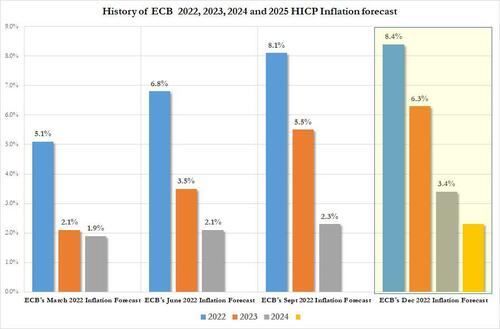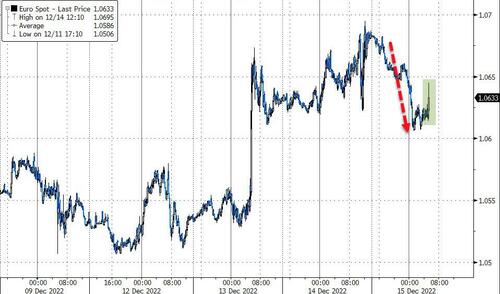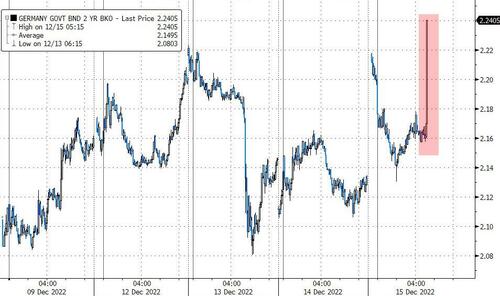Economics
“Anyone Who Thinks This Is A Pivot Is Wrong”: ECB Doubles Down On Hawkish Signals As it Hikes Into Recession
"Anyone Who Thinks This Is A Pivot Is Wrong": ECB Doubles Down On Hawkish Signals As it Hikes Into Recession
In summary, here are the top…

“Anyone Who Thinks This Is A Pivot Is Wrong”: ECB Doubles Down On Hawkish Signals As it Hikes Into Recession
In summary, here are the top give takeaways from the hawkish ECB policy decision and Lagarde’s even more hawkish press briefing (via BBG).
- The ECB opted for a 50 basis-point rate hike, following in the footsteps of the Fed and BOE with a slower pace of tightening
- Yet Lagarde and other officials set out to send a more hawkish message, stressing the ECB’s intention to raise rates significantly at a steady pace. “Anyone who thinks the ECB is pivoting is wrong”, she said.
- The reason is a significant increase in inflation forecasts, with even core inflation seen above target in 2025.
- The euro reversed losses to hit a six-month high versus the dollar; euro-area bonds dropped, German two-year yields surged by 28 basis points. The Euro has since dropped and reversed almost all gains, however.
- The ECB also gave an overview of how it expects to begin reducing its balance sheet, saying it will start in March at a “measured and predictable pace” amounting to €15 billion per month on average until the end of the second quarter
After successive hikes of 75 basis points, the ECB lifted the deposit rate more slowly on Thursday, to 2%, as economists expected. But there was little dovishness elsewhere: pledging to push borrowing costs “significantly” higher, officials widened efforts to tame prices with a decision to shrink their €5 trillion ($5.3 trillion) bond portfolio.
“Anybody who thinks that this is a pivot for the ECB is wrong,” Lagarde told a news conference. “We should expect to raise interest rates at a 50 basis-point pace for a period of time.”
“We have more ground to cover, we have longer to go and we are in for a long game,” she said.
And speaking of inflation, here is the ECB’s latest forecast.
Similar to the Fed, the ECB raised its inflation projections for the euro zone on Thursday and said price growth would remain above its 2% target throughout a projection horizon that now extends to 2025. Which is funny, because the ECB has persistently underestimated inflation over the past two years, and the bank has raised interest rates at four successive meetings to tame unexpectedly persistent price pressures. So it has gone from overly dovish to overly hawkish, and inflation will tumble long before the 2025 bogey.
In any case, the bank now sees inflation in the 19-country currency bloc at 6.3% next year, compared with expectations for 5.5% made in September. Its 2024 forecast was raised to 3.4% from 2.3% while, in its first estimate for 2025, the ECB sees inflation then at 2.3%. Initially driven by post-COVID supply chain bottlenecks – which the ECB had some control over – inflation has been surging on sky-high energy prices – which the ECB has no control over – but food and services costs are now becoming increasingly prominent, making price growth relatively broad.
Economic growth will meanwhile suffer badly next year as a result of Russia’s war in Ukraine, particularly the impact of high energy prices. The ECB now sees GDP growth at 0.5% next year – the same as the Fed does for the US and hints at a recession next year – compared with 0.9% forecast in September, while in 2024, it is projected at an unchanged 1.9%. In 2025, the ECB sees growth at 1.8%.
Traders added to rate-hike bets, pricing a deposit-rate peak of 3% next year, compared with 2.93% earlier. The Stoxx Europe 600 Index dropped as much as 2.5%, sinking to the lowest level in a month and the most in nearly two months as rates-sensitive sectors like technology and retailers slumped.
Lagarde said financial markets hadn’t adequately accounted for the amount borrowing costs would need to rise to quell inflation.
Earlier:
Expectations of a 50bps hike were pretty much locked in – so no surprise there at all from The ECB’s decision today (to hike 50bps), but the timing of the start of quantitative tightening is what most traders are eyeing with expectations for a ‘grey’ ‘first quarter of 2023’ range being expected (kicking the decision can down the road).
The 50bps follows the Fed, SNB, and Boe decisions in the last 24 hours, and the guidance that interest rates “will still have to rise significantly at a steady pace” sounds pretty hawkish.
Additionally, The ECB to continue to be flexible in its PEPP reinvestment (as needed) and added that QT will begin in March at a “measured, predictable pace”, with the average monthly decline in bonds will amount to 15 billion euros until the end of the second quarter.
???????? The ECB hikes rates by 50bp as expected, but gives *very* hawkish guidance, based on the “substantial upward revision” to inflation, noting that interest rates will still have to rise “significantly at a steady pace” to reach levels that are sufficiently restrictive. pic.twitter.com/uKT6PYsg85
— Frederik Ducrozet (@fwred) December 15, 2022
The ECB raised its inflation expectations and notably it remains above 2.0% targets into 2025…
-
ECB Sees Inflation at 6.3% in 2023, 3.4% in 2024, 2.3% in 2025
-
Sees Inflation Ex-Food, Energy at 4.2% in 2023; Prior 3.4%
-
Sees Inflation Ex-Food, Energy at 2.8% in 2024; Prior 2.3%
-
Sees Inflation Ex-Food, Energy at 2.4% in 2025
And cut 2023’s GDP forecast (while hiking 2022):
-
ECB Sees GDP at 3.4% in 2022; Prior Forecast 3.1%
-
ECB Sees GDP at 0.5% in 2023; Prior Forecast 0.9%
-
ECB Sees GDP at 1.9% in 2024; Prior Forecast 1.9%
The Euro has fallen on 5 of the last 7 ECB meeting days and while options implied this would be one of the quietest ECB days since April, there was still lots of room for volatility. For now the initial reaction is a small rebound in the Euro…
German 2Y yields spiked on the news…
Watch Lagarde live here (due to start at 0845T):
Full ECB Statement:
Monetary policy decisions
The Governing Council today decided to raise the three key ECB interest rates by 50 basis points and, based on the substantial upward revision to the inflation outlook, expects to raise them further. In particular, the Governing Council judges that interest rates will still have to rise significantly at a steady pace to reach levels that are sufficiently restrictive to ensure a timely return of inflation to the 2% medium-term target. Keeping interest rates at restrictive levels will over time reduce inflation by dampening demand and will also guard against the risk of a persistent upward shift in inflation expectations. The Governing Council’s future policy rate decisions will continue to be data-dependent and follow a meeting-by-meeting approach.
The key ECB interest rates are the Governing Council’s primary tool for setting the monetary policy stance. The Governing Council today also discussed principles for normalising the Eurosystem’s monetary policy securities holdings. From the beginning of March 2023 onwards, the asset purchase programme (APP) portfolio will decline at a measured and predictable pace, as the Eurosystem will not reinvest all of the principal payments from maturing securities. The decline will amount to €15 billion per month on average until the end of the second quarter of 2023 and its subsequent pace will be determined over time.
At its February meeting the Governing Council will announce the detailed parameters for reducing the APP holdings. The Governing Council will regularly reassess the pace of the APP portfolio reduction to ensure it remains consistent with the overall monetary policy strategy and stance, to preserve market functioning, and to maintain firm control over short-term money market conditions. By the end of 2023, the Governing Council will also review its operational framework for steering short-term interest rates, which will provide information regarding the endpoint of the balance sheet normalisation process.
The Governing Council decided to raise interest rates today, and expects to raise them significantly further, because inflation remains far too high and is projected to stay above the target for too long. According to Eurostat’s flash estimate, inflation was 10.0% in November, slightly lower than the 10.6% recorded in October. The decline resulted mainly from lower energy price inflation. Food price inflation and underlying price pressures across the economy have strengthened and will persist for some time. Amid exceptional uncertainty, Eurosystem staff have significantly revised up their inflation projections. They now see average inflation reaching 8.4% in 2022 before decreasing to 6.3% in 2023, with inflation expected to decline markedly over the course of the year. Inflation is then projected to average 3.4% in 2024 and 2.3% in 2025. Inflation excluding energy and food is projected to be 3.9% on average in 2022 and to rise to 4.2% in 2023, before falling to 2.8% in 2024 and 2.4% in 2025.
The euro area economy may contract in the current quarter and the next quarter, owing to the energy crisis, high uncertainty, weakening global economic activity and tighter financing conditions. According to the latest Eurosystem staff projections, a recession would be relatively short-lived and shallow. Growth is nonetheless expected to be subdued next year and has been revised down significantly compared with the previous projections. Beyond the near term, growth is projected to recover as the current headwinds fade. Overall, the Eurosystem staff projections now see the economy growing by 3.4% in 2022, 0.5% in 2023, 1.9% in 2024 and 1.8% in 2025.
Key ECB interest rates
The Governing Council decided to raise the three key ECB interest rates by 50 basis points. Accordingly, the interest rate on the main refinancing operations and the interest rates on the marginal lending facility and the deposit facility will be increased to 2.50%, 2.75% and 2.00% respectively, with effect from 21 December 2022.
Asset purchase programme (APP) and pandemic emergency purchase programme (PEPP)
The Governing Council intends to continue reinvesting, in full, the principal payments from maturing securities purchased under the APP until the end of February 2023. Subsequently, the APP portfolio will decline at a measured and predictable pace, as the Eurosystem will not reinvest all of the principal payments from maturing securities. The decline will amount to €15 billion per month on average until the end of the second quarter of 2023 and its subsequent pace will be determined over time.
As concerns the PEPP, the Governing Council intends to reinvest the principal payments from maturing securities purchased under the programme until at least the end of 2024. In any case, the future roll-off of the PEPP portfolio will be managed to avoid interference with the appropriate monetary policy stance.
The Governing Council will continue applying flexibility in reinvesting redemptions coming due in the PEPP portfolio, with a view to countering risks to the monetary policy transmission mechanism related to the pandemic.
Refinancing operations
As banks are repaying the amounts borrowed under the targeted longer-term refinancing operations, the Governing Council will regularly assess how targeted lending operations are contributing to its monetary policy stance.
The Governing Council stands ready to adjust all of its instruments within its mandate to ensure that inflation returns to its 2% target over the medium term. The Transmission Protection Instrument is available to counter unwarranted, disorderly market dynamics that pose a serious threat to the transmission of monetary policy across all euro area countries, thus allowing the Governing Council to more effectively deliver on its price stability mandate.
Tyler Durden
Thu, 12/15/2022 – 11:10
dollar
inflation
monetary
markets
policy
interest rates
fed
monetary policy

Argentina Is One of the Most Regulated Countries in the World
In the coming days and weeks, we can expect further, far‐reaching reform proposals that will go through the Argentine congress.
Crypto, Crude, & Crap Stocks Rally As Yield Curve Steepens, Rate-Cut Hopes Soar
Crypto, Crude, & Crap Stocks Rally As Yield Curve Steepens, Rate-Cut Hopes Soar
A weird week of macro data – strong jobless claims but…
Fed Pivot: A Blend of Confidence and Folly
Fed Pivot: Charting a New Course in Economic Strategy Dec 22, 2023 Introduction In the dynamic world of economics, the Federal Reserve, the central bank…






















